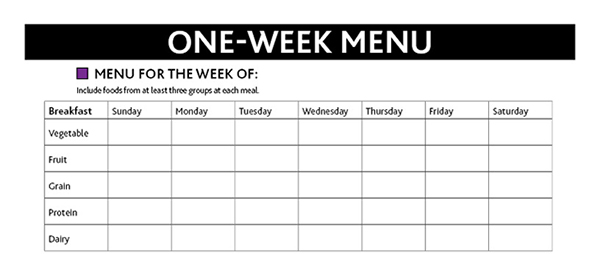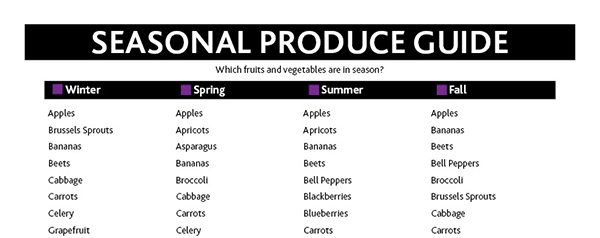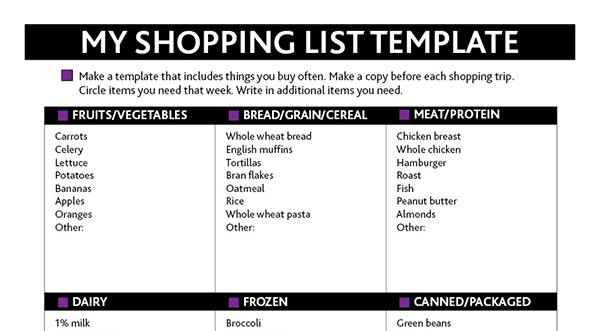Plan Smart
You'll save money and eat healthier when you prepare more meals at home. The key to success is planning ahead. Decide how much you can afford to spend, plan family-friendly meals that fit your budget and write your shopping list.
Watch Your Spending
Before deciding your food budget, find out how much your family spends on food now. For one week:
- Have everyone in the family save receipts for all their food purchases. Include food from grocery stores, convenience stores, gas stations, school or work cafeterias, vending machines, restaurants, coffee shops, the movies and anywhere else you buy food.
- Have everyone write their names on their receipts and put them in one place at the end of each day. If a receipt was lost or not provided, make a note of the purchase and how much it cost.
At the end of the week, sort receipts and notes into two piles. In one pile put receipts and notes for food you bought to prepare at home. In the other pile put receipts and notes for food you purchased at restaurants, the movies and so on.
Now add up the costs. (Print a copy of the spending worksheet to help with your tally (PDF).)
How much did your family spend on food to prepare at home? How much was spent on food away from home?
Do you see any places where you could easily cut back on food costs?
Small food purchases can add up
You might be surprised by how much you spend on small things, like a coffee on the way to work or a mid-morning snack. To calculate the yearly cost of your food-buying habits, multiply how often per week you buy something by how much it costs each time and then multiply by 52 weeks.
Suppose you buy coffee 5 days per week and it costs you $3 per day:
5 days per week x $3 per day x 52 weeks per year = $780 per year.
|
If you do this |
This often per week |
And it costs this much each time |
It will cost this much per year |
|---|---|---|---|
|
Buy coffee on the way to work |
5 days |
$3.00 |
$780 |
|
Buy a drive-through breakfast meal |
5 days |
$5.00 |
$1,300 |
|
Eat fast food for lunch |
3 days |
$5.00 |
$780 |
|
Eat at a restaurant for lunch |
2 days |
$12.00 |
$1,248 |
|
Get a soda from a vending machine |
5 days |
$1.50 |
$390 |
|
Buy a snack from a vending machine |
5 days |
$1.50 |
$390 |
|
Get fast food dinner for a family of 4 |
1 day |
$20.00 |
$1,040 |
|
Eat family dinner at a restaurant for family of 4 |
1 day |
$50.00 |
$2,600 |
If you did all of these, it would cost $8,528 per year.
What do you suppose is your family’s yearly total?
Print a copy of the buying habits worksheet (PDF) to figure the yearly costs of some of your own buying habits.
What could you do with money saved by eating meals and snacks from home? For example, your family might decide to:
- Eat breakfast before leaving home or pack a breakfast to go.
- Buy a thermos to carry coffee or other beverages.
- Pack lunches.
- Eat out less often.
Use the food cost calculator to estimate how much it should cost to feed your family using the United States Department of Agriculture’s (USDA) Low-cost Food Plan.
Compare what you are spending for food with the food calculator estimate. If you are spending less or about the same, you are doing a good job with your food money. Make sure you are making healthy choices and providing your family with the recommended amounts of food from each food group.
If you are spending more, use ideas from this website to plan, shop for, cook and eat healthy, low-cost meals.
Plan Your Meals
1. Save time.
It takes time to plan meals but saves time during the week. You'll get faster with practice. Save more time by reusing previous menus.
2. Save money.
You can save as much as 15 percent on your grocery bill by carefully planning meals. That's more than $100 for a $700 monthly food budget!
3. Eat healthier.
Use MyPlate as a guide.
4. Reduce stress.
Rest easy knowing you have a meal plan and all of the ingredients you need.
5. Eat together.
Meal time is a time to build family relationships. Plan meals so everyone can eat together often. Turn off the television, put other electronics away and talk together. Read more ideas for family meals.
Find a time when you can focus without distractions. You'll need the following information and tools to get started:
- Your food money. Know how much you have to spend so you can make a menu to match your budget.
- A menu template. Start with a one- or two-week menu. (Print a one-week (PDF) or two-week (PDF) menu template.)

- Your calendar. Look at how much time you have to cook each night. Prepare simple meals on busy nights. Note special events such as birthdays and holidays that will affect what you have for dinner.
- School lunch menu. If your child takes a home-prepared lunch to school, write those meals on your plan.
Look in your pantry, refrigerator and freezer for ingredients you have on hand. Plan to use these first, while they're still fresh. Try these ideas:
- Use leftovers for lunch or for some dinners.
- Use leftover vegetables, pasta or rice and meat or beans to make a casserole, soup or stir-fry.
- Add leftover vegetables to pasta sauce, salads, omelets or pizza.
- Use leftover meat in sandwiches, quesadillas or scrambled eggs.
- Blend ripe fruit, yogurt, fruit juice and milk to make a smoothie.
Check newspaper or online advertisements for great buys. Keep a book to track prices of foods you buy often so you know when “sales” really are good deals.
Match sale items to meals your family likes. Have family members help you make a list of easy, inexpensive, nutritious recipes that you all like. Put the recipes into categories such as these to simplify planning:
- Protein foods: chicken, pork, beef, fish/seafood, dried beans, eggs and nuts
- Dishes from other countries: Italian, Mexican, Chinese
- Freezer meals
- Slow-cooker meals
- Breakfast for dinner
- Soup or stew
- No-cook meals such as sandwiches or salads
- Planned leftovers. Make a double batch of a recipe and freeze part for another day. Or prepare some ingredients for a future meal such as chopping extra vegetables, browning ground beef or grating extra cheese. See Cook Smart for more ideas.
- Other
Fresh vegetables and fruits usually taste best. Buy them when they're in season and more affordable. (Print a copy of the seasonal produce guide (PDF).) Frozen and canned vegetables and fruits are nutritious and provide variety throughout the year.

After making your meal plan, review each meal:
- Did you include foods from at least three food groups?
- Is there a variety of shapes, colors, flavors, textures and temperatures? Variety helps your meal look and taste great.
Write a Shopping List
Save time.
An organized shopping list helps you get in and out of the store quickly.
Save money.
People spend about $2.17 for every minute they are in a grocery store. Quicker shopping means you’ll spend less money. Sticking to a shopping list will also help you avoid buying on impulse.
Make fewer trips to the store.
Extra shopping trips take time and gas and increase the chance of impulse buying. Make a complete list before shopping and you are more likely to get everything you need.
Check your pantry, refrigerator and freezer for what you already have. List the foods you still need. Add needed staple foods such as flour, sugar, coffee and rice. List only as many fresh vegetables and fruits as you can use before they spoil.
Save time and money by going down only the aisles that have food you need. Group your food items something like this (Print my shopping list (PDF).):
- Fruits/vegetables
- Bread/grain/cereal
- Meat/protein
- Dairy
- Frozen
- Canned/packaged
- Staples
- Non-food
- Other
If you like, make a shopping list template that includes things you buy often and copy or print it before each shopping trip. Circle items you need that week. For example, the dairy column might list milk, cheddar cheese, string cheese, mozzarella cheese, plain yogurt, strawberry yogurt, cottage cheese and sour cream. Write in any additional dairy items you need. (Print the sample shopping list template (PDF).)

Train yourself and your family to add things to the shopping list before you are completely out of them. Put the list with a pen or pencil in a place where all family members can easily see and add to it.
Ask yourself these questions:
- Have I included ingredients for all the breakfasts, lunches and dinners on my menus as well as ingredients for snacks?
- Does it look like the items on my list will fit my food budget? If it looks like the food will cost more than you have budgeted, take some things off the list. You could also put them in a separate place in your cart and buy them only if you have enough money at checkout.
- Do I have coupons for any foods on the list? Are any of the foods on sale? If so, note this on your list so you remember to use the coupon or to check that you were charged the sale price.

